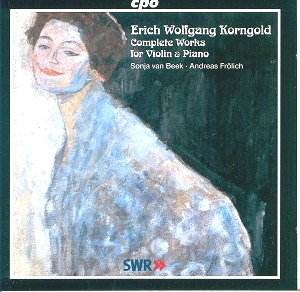Erich Wolfgang KORNGOLD (1897-1957)
Complete works for violin and piano:
Violin Sonata Op. 6 in G
Tanzlied des Pierrot (Die tote Stadt)
Marriettas Lied zur Laute (Die tote Stadt)
Caprice fantastique
Serenade (Der Schneemann)
Gesang der Heliane (Das Wunder der Heliane)
Much Ado About Nothing suite
 Sonja van Beek (violin) and
Andreas Frölich (piano)
Sonja van Beek (violin) and
Andreas Frölich (piano)
 cpo 999 709-2 [72:05]
midprice
cpo 999 709-2 [72:05]
midprice
Crotchet
Amazon UK
AmazonUS

Korngold composed his Violin Sonata in G, in 1912 when he was only
fifteen. He was encouraged to write it by Carl Flesch and Artur Schnabel;
and it was they who premiered it. The Violin Sonata is a virtuoso piece placing
high and, in part, extreme demands on the violinist; and the piano part often
has dense textures. It is classical-Romantic in idiom with emotion enough
but without the 'heart-on-sleeve' effulgence we have come to associate with
the operas and the film music. There are difficulties of co-ordination through
Korngold's complex rhythmic and dynamic writing. Tonally, the sonata recalls
compositions from Zemlinsky (Korngold's teacher) and the late-Romantic coloration
of Schönberg. Added to this complexity, is the unusual if not extraordinary
shape of the Scherzo which at nearly twelve minutes duration, here, is longer
than any of the other three movements. This scherzo covers a wide range of
emotions. Although it is undeniably Viennese in character, there is violence
and heavy drama, ruminative material and quasi-military figures well as the
dance material (particularly waltz measures) that one associates more with
a scherzo. Andreas Frölich's attack consistently impresses but van Beek
sometimes gives the impression that she is holding back - a more emotional
involvement would not have gone amiss.
I have to say that I was disappointed in this same tentativeness in the two
pieces from Die tote Stadt. These are dreamily romantic; but here
the playing is too matter-of-fact, little commitment, little romance. Things
improve when there is a chance to show off technique in the imaginatively
quirky witches' music that is Caprice fantastique. The salon
music that is the Serenade from Der
Scheemann is nicely judged, so too is the 'verbal-melancholy' of the
Song of Heliane.
But the most memorable music and most instantly appealing is the popular
Much Ado About Nothing suite. Here it is a sparkling
confection with the beautiful coy 'Mädchen im Brautgemach' (one of
Korngold's loveliest melodies) contrasting with the amusingly clumsy gait
of 'Halzapfel und Schlehenwein' (anticipating the Sherwood Forest music from
The Adventures of Robin Hood). Next there is the blissfully romantic
Gartenscene, and, in conclusion, the merriment of 'Mummenschanz'.
A valuable addition to the Korngold discography that would have benefited
more from more expressive playing.
Ian Lace

